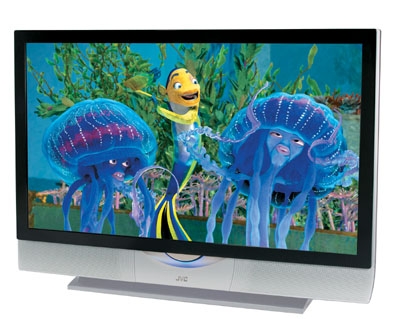Big-Screen Values Page 3
DLP, LCD, LCoS Rear-Projection

The biggest thing to hit big-screen HDTV since NFL Sunday Ticket, microdisplay rear-projection encompasses three similar technologies called LCD (liquid-crystal display), DLP (Digital Light Processing), and LCoS (liquid crystal on silicon). You can generally get similar-size microdisplays, regardless of the display technology, for around the same price. These digital big-screens cost about 50% more per square inch of screen than their tube counterparts, but prices are falling faster than ever.
How They Work I call these TVs "digital" because, unlike tube-based analog rear-projectors, microdisplays rely on one or more imaging chips that create a discrete number of onscreen pixels - usually 1,280 x 720 (720p) or 1,920 x 1,080 (1080p). Think of these TVs as projectors in a box - light from a lamp interacts with the chip, mirrors, lenses, and other elements to create an image, which is then projected onto the back of a large screen.
DLP microdisplays use a single chip called a Digital Micromirror Device (DMD), packed with nearly a million mirrors that reflect light from a lamp onto a screen. A rapidly-spinning color wheel infuses the monochromatic image with color for the screen.
LCD-based microdisplays - many of which are now being marketed as "3LCD" - use three chips packed with liquid-crystal-filled cells. The crystals untwist to regulate red, green, or blue light that passes through, and that light is recombined and sent to the screen.
LCoS borrows from both LCD and DLP technology. Like LCD, each silicon chip has liquid crystals that untwist to filter light, and as in DLP, light is reflected off the chip toward a screen. Today's LCoS displays - including JVC's popular HD-ILA models and Sony's SXRD sets - all use three separate chips for red, green, and blue.
Pros •Microdisplays can produce much brighter images than conventional big-screen CRTs, so their pictures show up better in bright rooms and remain more consistent regardless of viewing angle. DLP and LCoS are typically brighter than LCD rear-projection. •Sharp picture. Microdisplays don't need alignment and suffer fewer convergence or geometry errors than tube rear-projection sets. Their discrete pixels generally allow them to display more detailed DVD, high-def, and computer images. •Unlike with big-screen CRTs, there's no danger of burn-in. •Cabinets are lighter and much less bulky - especially in terms of depth - than the big boxes required by CRT sets. Some designs are even slim enough to hang on the wall like a plasma TV.
Cons •Microdisplays are still more expensive than the same-size CRT sets. •Unlike tube sets, microdisplays still can't achieve a true black, which is particularly important when watching movies in darkened rooms or when watching a program with dark images. But the best microdisplays do such a good job with blacks that any flaws will only be apparent to highly trained viewers. •DLPs are prone to a "rainbow" effect. Although the color wheel that separates the white light spins very fast, you might see streaks of primary color if you look closely enough or blink at just the right moment. But not all viewers will notice this. •LCDs can exhibit a "screen-door" effect, where the pixel grid becomes visible when you sit near the screen. •The lamps burn out. Typical lamps last 3,000 hours and cost around $300 to replace.
Entry Point: $1,500 I found a 42-inch Samsung DLP selling for $1,499, but the real value starts at the 50-inch and larger screen sizes. Models like the 52-inch JVC HD-52Z575 LCoS set we reviewed in January and the Toshiba 52HDM94 DLP model from the June issue were selling for around $1,800 when I checked. (Bargain hunters: it pays to seek out older models.) Among current models, a good example is the 50-inch DLP-driven 50LPW175 from RCA, which costs $2,299 at Best Buy. Larger sizes offer even more picture for your buck. JVC has a 61-inch LCoS set for $2,700, which works out to $1.70 per square inch of screen.




























































